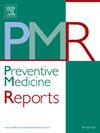Independent and joint associations of neighbourhood greenness and walkability with transportational and recreational physical activity among youth and adults in Canada
IF 2.4
3区 医学
Q2 PUBLIC, ENVIRONMENTAL & OCCUPATIONAL HEALTH
引用次数: 0
Abstract
Objectives
Greener neighbourhoods may support physical activity; however, it is also important to consider whether greener neighbourhoods are walkable. We assessed whether neighbourhood greenness and walkability were independently and jointly associated with transportational (PATRA) and recreational (PAREC) physical activity among a nationally representative sample of urban-dwelling youth and adults in Canada.
Methods
We analyzed repeated cross-sectional data from 132,927 urban-dwelling youth (12–17 years) and adults (≥18 years) who participated in the Canadian Community Health Survey (2015–2018). To derive an indicator of neighbourhood greenness, for each survey year, we aggregated mean Normalized Difference Vegetation Index (NDVI) values within 2016 dissemination areas. As a proxy for neighbourhood walkability, we used 2016 Canadian Active Living Environments (Can-ALE) metrics. We used weighted linear regressions to examine whether, and the extent to which, neighbourhood NDVI and the Can-ALE index were independently and jointly associated with self-reported and log-transformed PATRA and PAREC, while adjusting for individual and neighbourhood characteristics.
Results
Among adults, but not youth, higher NDVI was independently associated with higher PATRA (β = 0.2, 95 % CI 0.02, 0.36) and PAREC (β = 0.3, 95 % CI 0.14, 0.47). Among both youth (β = 0.4, 95 % CI 0.21, 0.66) and adults (β = 0.3, 95 % CI 0.22, 0.35), NDVI and Can-ALE were jointly associated with PATRA.
Conclusion
Living in a neighbourhood that is both greener and more walkable was more strongly associated with higher transportational, but not recreational, physical activity, than either feature alone. These novel findings highlight the importance of designing cities that are both greener and more walkable to promote active living.
求助全文
约1分钟内获得全文
求助全文
来源期刊

Preventive Medicine Reports
Medicine-Public Health, Environmental and Occupational Health
CiteScore
3.90
自引率
0.00%
发文量
353
 求助内容:
求助内容: 应助结果提醒方式:
应助结果提醒方式:


